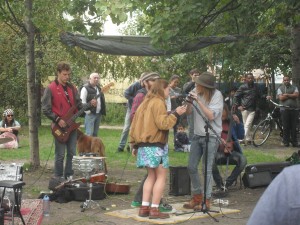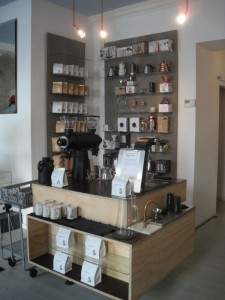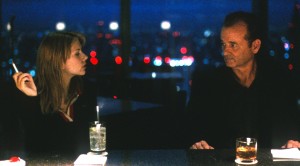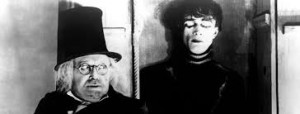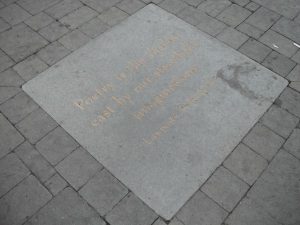 Just back from over three weeks in the States where our adventure began with a return trip to San Francisco (fifth visit to date…) where the streets are paved with poetry…
Just back from over three weeks in the States where our adventure began with a return trip to San Francisco (fifth visit to date…) where the streets are paved with poetry…
Poetry is the shadow cast by our streetlight imaginations (Lawrence Ferlinghetti).
First stop, as always, City Lights Bookshop to celebrate the Beat poets and their groundbreaking work. Although the Beat movement started in New York just after the Second World War, by the 1950s it was firmly entrenched in San Francisco. Poets such as Allen Ginsberg, Lawrence Ferlinghetti, Gary Snyder and Gregory Corso questioned mainstream politics and culture and battled against social conformity in new and refreshing ways, very much like our Angry Young Men movement in Britain, also a product of post-war disillusionment. The bookstore was opened in 1953 by Ferlinghetti and published Ginsberg’s Howl, go to www.citylights.com/info/?fa=aboutus to find out more about this wonderful bookstore/publisher which retains its intimacy despite its popularity.
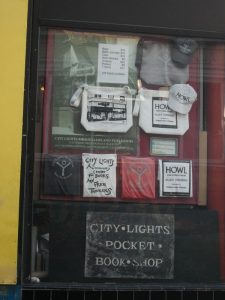
My favourite section is, of course, the Poetry Room upstairs and I always ensure I have plenty of time to sit in the Poet’s Chair in the hope that I’ll gain divine inspiration from the generations of poets who must have sat there before me. Indeed, there’s even a notice to ask people to treat the chair with reverence – it’s a rocking chair and one over-enthusiastic poet (not guilty!) previously caused extensive damage.
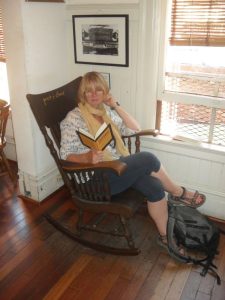 Here’s an extract from my imaginatively titled new poem “September in San Francisco”:
Here’s an extract from my imaginatively titled new poem “September in San Francisco”:
Rocking in the Poet’s Chair in City Lights Bookshop,
cool breezes from the alley below,
Lawrence Ferlinghetti speaks to me
in half-sentences with no commas of the gone world
and I understand for the first time.
If you want to find out more about the Beats then the film Howl starring James Franco as Ginsberg and focusing on the revolutionary obscenity trial surrounding its publication is a great place to start.
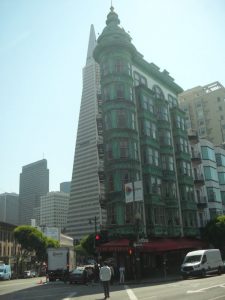 San Francisco oozes cinematic references and while Chris had fun at the Oakland A’s ballpark I went on a Silent Film San Francisco walking tour. It’s possible that if it hadn’t been for the 1906 earthquake and subsequent fires which devastated the city that it would have been the hub of American film instead of Hollywood (although the famous San Francisco fog may have put off studio moguls…). What better way to recover from a walking tour than a glass of chilled white wine, and what better place to sip it than Francis Ford Coppola’s very own restaurant, Café Zoetrope (www.cafezoetrope.com) which serves wine from his very own vineyard! The café is in the historic Sentinel Building, one of the post-earthquake landmarks, which, at one point, housed a recording studio owned by The Kingston Trio where bands like the Grateful Dead hired the space. Coppola bought the building in 1972 to use for his production company, American Zoetrope, which he founded with George Lucas. A number of Coppola’s films including the Godfather II and III, Apocalypse Now, The Conversation, One From The Heart, The Outsiders, and Dracula were written, edited, or sound mixed there and the walls of the Café, which Coppola created in 1999, are full of fascinating Coppola memorabilia. Oh, and my 2010 Chardonnay Director’s Cut (Sonoma Coast) was excellent!
San Francisco oozes cinematic references and while Chris had fun at the Oakland A’s ballpark I went on a Silent Film San Francisco walking tour. It’s possible that if it hadn’t been for the 1906 earthquake and subsequent fires which devastated the city that it would have been the hub of American film instead of Hollywood (although the famous San Francisco fog may have put off studio moguls…). What better way to recover from a walking tour than a glass of chilled white wine, and what better place to sip it than Francis Ford Coppola’s very own restaurant, Café Zoetrope (www.cafezoetrope.com) which serves wine from his very own vineyard! The café is in the historic Sentinel Building, one of the post-earthquake landmarks, which, at one point, housed a recording studio owned by The Kingston Trio where bands like the Grateful Dead hired the space. Coppola bought the building in 1972 to use for his production company, American Zoetrope, which he founded with George Lucas. A number of Coppola’s films including the Godfather II and III, Apocalypse Now, The Conversation, One From The Heart, The Outsiders, and Dracula were written, edited, or sound mixed there and the walls of the Café, which Coppola created in 1999, are full of fascinating Coppola memorabilia. Oh, and my 2010 Chardonnay Director’s Cut (Sonoma Coast) was excellent!
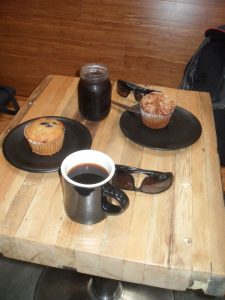 The coffee scene in San Francisco is to die for, you can’t move for Third Wave Coffee shops. One of my favourites was Flywheel Coffee Roasters in Haight Ashbury, just opposite Golden Gate Park. The company was founded by Aquiles Guerrero, a Nicaraguan who grew up on a coffee estate so he certainly knows his stuff. We discovered they also did vegan muffins which went very well with my cold brew coffee (steeped in cold water for 18-24 hours, this is one of the hot(!) new trends in the coffee world). I also tried a nitro sample which is, apparently, the next step after cold brew. The coffee is infused with nitrogen to give it a Guinness-like flavour – it’s really smooth and comes with a frothy head, it also packs quite a kick!
The coffee scene in San Francisco is to die for, you can’t move for Third Wave Coffee shops. One of my favourites was Flywheel Coffee Roasters in Haight Ashbury, just opposite Golden Gate Park. The company was founded by Aquiles Guerrero, a Nicaraguan who grew up on a coffee estate so he certainly knows his stuff. We discovered they also did vegan muffins which went very well with my cold brew coffee (steeped in cold water for 18-24 hours, this is one of the hot(!) new trends in the coffee world). I also tried a nitro sample which is, apparently, the next step after cold brew. The coffee is infused with nitrogen to give it a Guinness-like flavour – it’s really smooth and comes with a frothy head, it also packs quite a kick!
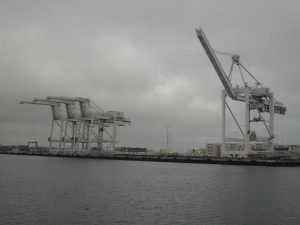 Another favourite was Blue Bottle Coffee which we discovered on a trip to Oakland across the Bay (coupled with a baseball game of course!). We took the ferry – check out the cranes in the docks – they have to be George Lucas’s (a local lad) inspiration for the huge white fighting machines in Star Wars. Oakland is a strange city, blue-collar, run-down but also deeply trendy and happening and full of vintage cinemas! Only one of the cinemas is still operating as such, The Grand Lake Theater,
Another favourite was Blue Bottle Coffee which we discovered on a trip to Oakland across the Bay (coupled with a baseball game of course!). We took the ferry – check out the cranes in the docks – they have to be George Lucas’s (a local lad) inspiration for the huge white fighting machines in Star Wars. Oakland is a strange city, blue-collar, run-down but also deeply trendy and happening and full of vintage cinemas! Only one of the cinemas is still operating as such, The Grand Lake Theater, 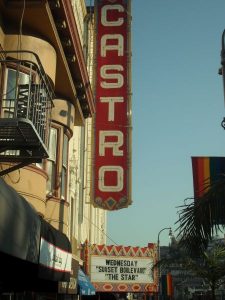 and we couldn’t factor in a visit this time but compensated with a double-bill at our favourite SF cinema, The Castro, where even the usherettes became famous movie stars – Janet Gaynor started her career here! The Castro is always an experience, a mighty Wurlitzer performance begins each show with cheesy classics. The audience clap and cheer when the stars come on and are, overall, very interactive… “Sunset Boulevard” was a joy, as always, and the accompanying film, “The Star” featured a wonderfully hammy Bette Davis. At one point I did wonder if someone was holding up cue cards for her with the pauses marked in all the wrong places…
and we couldn’t factor in a visit this time but compensated with a double-bill at our favourite SF cinema, The Castro, where even the usherettes became famous movie stars – Janet Gaynor started her career here! The Castro is always an experience, a mighty Wurlitzer performance begins each show with cheesy classics. The audience clap and cheer when the stars come on and are, overall, very interactive… “Sunset Boulevard” was a joy, as always, and the accompanying film, “The Star” featured a wonderfully hammy Bette Davis. At one point I did wonder if someone was holding up cue cards for her with the pauses marked in all the wrong places…
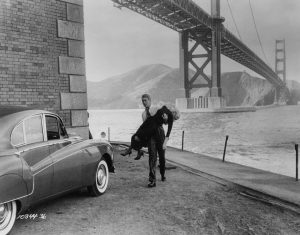 San Francisco’s most famous appearance in film is, without a doubt, Hitchcock’s Vertigo and we went on a fascinating “Hitchcock’s San Francisco” walk. We did around six walks, all with the same organisation www.sfcityguides.org – well worth checking out. I’m due to teach a Cities on Screen session on films featuring San Francisco so took lots of geeky photos but felt I should be swanning around in heels, a grey, tailored suit and a classy handbag like Kim Novak rather than jeans and flatties.
San Francisco’s most famous appearance in film is, without a doubt, Hitchcock’s Vertigo and we went on a fascinating “Hitchcock’s San Francisco” walk. We did around six walks, all with the same organisation www.sfcityguides.org – well worth checking out. I’m due to teach a Cities on Screen session on films featuring San Francisco so took lots of geeky photos but felt I should be swanning around in heels, a grey, tailored suit and a classy handbag like Kim Novak rather than jeans and flatties.
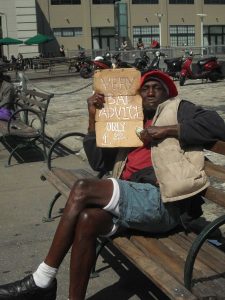 One of the downsides of San Francisco is the number of homeless people in the downtown area living rough amidst the affluence. How they manage to muster a sense of humour is beyond me, but the evidence speaks for itself!
One of the downsides of San Francisco is the number of homeless people in the downtown area living rough amidst the affluence. How they manage to muster a sense of humour is beyond me, but the evidence speaks for itself!
Very Bad Advice Only $1
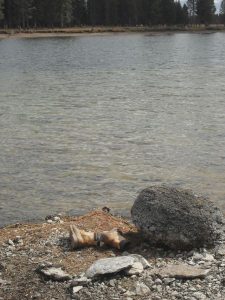 Those of you who come to my creative writing classes know that I’m an inveterate collector of images to use as writing prompts and, for all you budding writers out there, I thought you might enjoy these two photos, both taken in Yellowstone National Park which was our next stop for eight days of sparkling wilderness and bear-spotting!
Those of you who come to my creative writing classes know that I’m an inveterate collector of images to use as writing prompts and, for all you budding writers out there, I thought you might enjoy these two photos, both taken in Yellowstone National Park which was our next stop for eight days of sparkling wilderness and bear-spotting!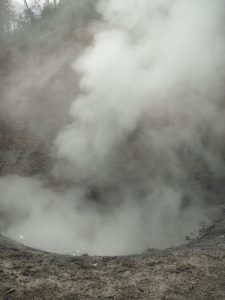
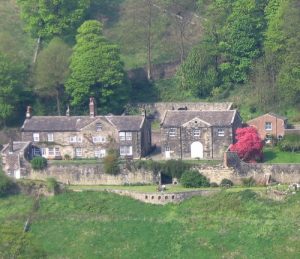 I’ve just returned from my second Arvon course under the Arts Council grant, this time at Lumb Bank, an imposing eighteenth century mill owner’s manse glowering down a steeply wooded hillside to where the ruined mill chimneys can still be seen. The concept of Arvon, the grandaddy of UK creative writing courses, was founded in Devon by poets John Moat and John Fairfax in l968 as a reaction against what they saw as a staid, dogmatic approach to teaching poetry. Lumb Bank was Ted and Carol Hughes’ home for a short while and was leased to Arvon when Hughes suggested it was time to open a Northern centre. The Arvon formula is the same in all three centres: two tutors, a guest reader mid-week and up to 16 anxious but starry-eyed participants. Fantastic poets and tutors Jean Sprackland and Jacob Polley had fun with an ever-changing good cop/bad cop formula and knocked us all into better shape with grace, sensitivity and humour, coaxing (or, perhaps, ripping!) seven very different poems out of me in just four days. Sean Borodale arrived on Wednesday night for his guest slot looking like a floppy-haired 21st century version of Keats to read his profound and erudite poems on subjects ranging from peeling and stewing apples to an extraordinary contemplation of a queen bee…
I’ve just returned from my second Arvon course under the Arts Council grant, this time at Lumb Bank, an imposing eighteenth century mill owner’s manse glowering down a steeply wooded hillside to where the ruined mill chimneys can still be seen. The concept of Arvon, the grandaddy of UK creative writing courses, was founded in Devon by poets John Moat and John Fairfax in l968 as a reaction against what they saw as a staid, dogmatic approach to teaching poetry. Lumb Bank was Ted and Carol Hughes’ home for a short while and was leased to Arvon when Hughes suggested it was time to open a Northern centre. The Arvon formula is the same in all three centres: two tutors, a guest reader mid-week and up to 16 anxious but starry-eyed participants. Fantastic poets and tutors Jean Sprackland and Jacob Polley had fun with an ever-changing good cop/bad cop formula and knocked us all into better shape with grace, sensitivity and humour, coaxing (or, perhaps, ripping!) seven very different poems out of me in just four days. Sean Borodale arrived on Wednesday night for his guest slot looking like a floppy-haired 21st century version of Keats to read his profound and erudite poems on subjects ranging from peeling and stewing apples to an extraordinary contemplation of a queen bee…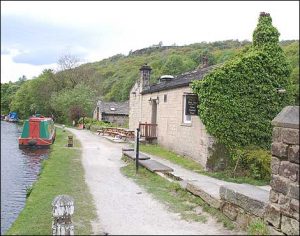 The weather was glorious except for the day I had cooking and washing up duty (sometimes the best-laid plans actually work out!). I did a daily walk down to Hebden Bridge to sit by the canal with a beer at Stubbings Wharf or a coffee at The Den watching the sun on the painted barges and dodging the hissing geese before the steep walk back up via Heptonstall.
The weather was glorious except for the day I had cooking and washing up duty (sometimes the best-laid plans actually work out!). I did a daily walk down to Hebden Bridge to sit by the canal with a beer at Stubbings Wharf or a coffee at The Den watching the sun on the painted barges and dodging the hissing geese before the steep walk back up via Heptonstall.  Sylvia Plath is buried in the new graveyard in this village which is a fifteen-minute walk from Lumb Bank. I’ve been to this area quite a bit and was glad that I’d already “done” my Sylvia Plath poem some years back – it’s hard not to be influenced by these two extraordinary poets and hard not to let the beauty and harshness of nature overwhelm your poems. There was even a cat called Ted, although it was from the farm down the road and turned out to be a girl…
Sylvia Plath is buried in the new graveyard in this village which is a fifteen-minute walk from Lumb Bank. I’ve been to this area quite a bit and was glad that I’d already “done” my Sylvia Plath poem some years back – it’s hard not to be influenced by these two extraordinary poets and hard not to let the beauty and harshness of nature overwhelm your poems. There was even a cat called Ted, although it was from the farm down the road and turned out to be a girl…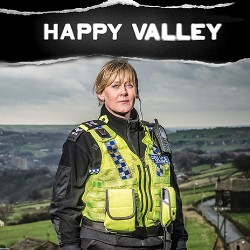 I discovered that one of the participants on the course had stayed in the same cottage in Mytholmroyd last April that Chris and I had rented in November during my birthday week. One of my presents was the first series of Happy Valley – it was a rainy week and we couldn’t stop watching it. Sally Wainwright’s flawless script, superb acting from a wonderful cast, particularly Sarah Lancashire and James Norton, and the fact that every night we walked along the dark canal back from Hebden Bridge to Mytholmroyd, passing the exact spot where the chillingly psychopathic Tommy Lee Royce had been hiding, all added to the dark and rather magnificent claustrophobia which permeates the Calder Valley on winter days. Sally Wainwright went to school in Sowerby Bridge and most of her scripts touch on this area (Sparkhouse, Scott and Bailey, Unforgiven etc) and, of course, Catherine Cawood, Sarah Lancashire’s character in Happy Valley, is often seen in Heptonstall at the graveside of her daughter Rebecca who is the invisible motivating factor behind the whole series. Calderdale has been used as a feature film location since Cecil Hepworth’s Helen of the Four Gates in 1920 and, with its sinister moor and heathlands, steep climbs, cobbled villages and solid stone buildings, it never fails to be a character in its own right.
I discovered that one of the participants on the course had stayed in the same cottage in Mytholmroyd last April that Chris and I had rented in November during my birthday week. One of my presents was the first series of Happy Valley – it was a rainy week and we couldn’t stop watching it. Sally Wainwright’s flawless script, superb acting from a wonderful cast, particularly Sarah Lancashire and James Norton, and the fact that every night we walked along the dark canal back from Hebden Bridge to Mytholmroyd, passing the exact spot where the chillingly psychopathic Tommy Lee Royce had been hiding, all added to the dark and rather magnificent claustrophobia which permeates the Calder Valley on winter days. Sally Wainwright went to school in Sowerby Bridge and most of her scripts touch on this area (Sparkhouse, Scott and Bailey, Unforgiven etc) and, of course, Catherine Cawood, Sarah Lancashire’s character in Happy Valley, is often seen in Heptonstall at the graveside of her daughter Rebecca who is the invisible motivating factor behind the whole series. Calderdale has been used as a feature film location since Cecil Hepworth’s Helen of the Four Gates in 1920 and, with its sinister moor and heathlands, steep climbs, cobbled villages and solid stone buildings, it never fails to be a character in its own right.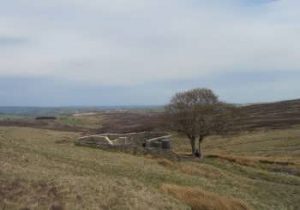 On my birthday we walked from Haworth back to Hebden Bridge via Top Withens (Wuthering Heights to you and me!) on the kind of foggy day that just makes you want to write intensely passionate and romantic poetry (although I was slightly distracted by the fact that I’d turned my left eye into a giant purple puffball by picking a mushroom, trying to identify it and then rubbing my eye…)
On my birthday we walked from Haworth back to Hebden Bridge via Top Withens (Wuthering Heights to you and me!) on the kind of foggy day that just makes you want to write intensely passionate and romantic poetry (although I was slightly distracted by the fact that I’d turned my left eye into a giant purple puffball by picking a mushroom, trying to identify it and then rubbing my eye…)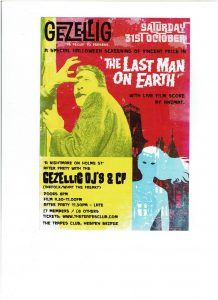 We also had a rather more up-to-date and positively post-apocalyptic experience that week when we went to the fantastic Trades Club on Hallowe’en to see a screening of Last Man on Earth, a schlocky B-movie made in Italy at the height of the horror era in 1968 (adapted from Richard Matheson’s novel I Am Legend and remade under this title in 2007 with Will Smith. There’s also a 1971 remake, The Omega Man, starring Charlton Heston). It stars Vincent Price as Dr Robert Morgan who wakes every morning in his garlic- festooned house to go vampire hunting (the film’s baddies are a confusing mix of zombie and vampire). The screening was accompanied with live music from Animat who used a mixture of their own brand of dubby downtempo music as well as an eclectic selection of tracks from their DJ archive including, inevitably, Thriller! Holme Street, where the Trades Club is situated, is a cul-de-sac T-junctioned by the Rochdale Canal and it tends to attract all sorts at night… We emerged into the darkness to be met by a ragged bunch of men staggering around in an inarticulate manner with an excitable black dog, echoing the repeated scenes in The Last Man on Earth where Vincent Price encounters angry zombies every morning when he opens his door and he even inadvertently adopts a zombie dog (black, of course!).
We also had a rather more up-to-date and positively post-apocalyptic experience that week when we went to the fantastic Trades Club on Hallowe’en to see a screening of Last Man on Earth, a schlocky B-movie made in Italy at the height of the horror era in 1968 (adapted from Richard Matheson’s novel I Am Legend and remade under this title in 2007 with Will Smith. There’s also a 1971 remake, The Omega Man, starring Charlton Heston). It stars Vincent Price as Dr Robert Morgan who wakes every morning in his garlic- festooned house to go vampire hunting (the film’s baddies are a confusing mix of zombie and vampire). The screening was accompanied with live music from Animat who used a mixture of their own brand of dubby downtempo music as well as an eclectic selection of tracks from their DJ archive including, inevitably, Thriller! Holme Street, where the Trades Club is situated, is a cul-de-sac T-junctioned by the Rochdale Canal and it tends to attract all sorts at night… We emerged into the darkness to be met by a ragged bunch of men staggering around in an inarticulate manner with an excitable black dog, echoing the repeated scenes in The Last Man on Earth where Vincent Price encounters angry zombies every morning when he opens his door and he even inadvertently adopts a zombie dog (black, of course!). My visit this time was tinged with sadness, but also admiration. The effect of the Boxing Day floods last year are still very much in evidence. It has taken so long for many of the shops and houses to dry out that building and repair work has only just begun. I was delighted to see that favourite bookshop The Book Case had re-opened, but shocked to see that their floodmarker for December 2015 was level with my eyebrows… Overall, the atmosphere was positive and forward-looking, these people are tough and tenacious and their refusal to be defeated by overwhelming odds moved me considerably.
My visit this time was tinged with sadness, but also admiration. The effect of the Boxing Day floods last year are still very much in evidence. It has taken so long for many of the shops and houses to dry out that building and repair work has only just begun. I was delighted to see that favourite bookshop The Book Case had re-opened, but shocked to see that their floodmarker for December 2015 was level with my eyebrows… Overall, the atmosphere was positive and forward-looking, these people are tough and tenacious and their refusal to be defeated by overwhelming odds moved me considerably.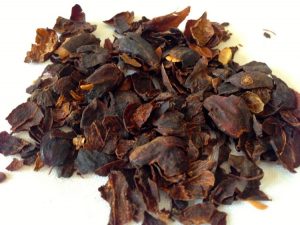 So, finally, our quest to be the geekiest of third-wave coffee seekers scaled new heights this summer as I dropped in to the wonderful and aromatic Caravan (
So, finally, our quest to be the geekiest of third-wave coffee seekers scaled new heights this summer as I dropped in to the wonderful and aromatic Caravan (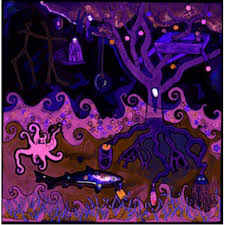 So, this month we’ve been listening to I, Gemini. Definitely the sound of summer, this is the debut album of Let’s Eat Grandma, Norwich-based teenage duo Rosa Walton and Jenny Hollingworth, both are multi-instrumentalists as well as singer-songwriters. The album is getting great reviews, it’s trancey, psychedelic pop, deeply weird and wonderful… I’ve known Rosa since she was born as I’m a good pal of mum Adrienne and was delighted to discover that the band were playing twice while I was in Paris. The first gig was at Point Ephémère, a trendy warehouse venue by Canal St Martin and the girls were playing as part of Rough Trade’s Pop-up Store on Record Store Day (Jour Disquaire). Their second gig was at Les Trois Baudets in the Pigalle area, just up the road from the Museum of Erotica. Adrienne and I went for coffee and cake at the Amelie café (Café des Deux Moulins) and then joined the girls, Lee, their technician and Philippe, the record label’s local rep, for dinner in the great café above the venue. Let’s Eat Grandma played their brilliant brand of pixie pop to an appreciative and enthusiastic audience and I helped out for a few minutes on the merch stall afterwards which was dead exciting
So, this month we’ve been listening to I, Gemini. Definitely the sound of summer, this is the debut album of Let’s Eat Grandma, Norwich-based teenage duo Rosa Walton and Jenny Hollingworth, both are multi-instrumentalists as well as singer-songwriters. The album is getting great reviews, it’s trancey, psychedelic pop, deeply weird and wonderful… I’ve known Rosa since she was born as I’m a good pal of mum Adrienne and was delighted to discover that the band were playing twice while I was in Paris. The first gig was at Point Ephémère, a trendy warehouse venue by Canal St Martin and the girls were playing as part of Rough Trade’s Pop-up Store on Record Store Day (Jour Disquaire). Their second gig was at Les Trois Baudets in the Pigalle area, just up the road from the Museum of Erotica. Adrienne and I went for coffee and cake at the Amelie café (Café des Deux Moulins) and then joined the girls, Lee, their technician and Philippe, the record label’s local rep, for dinner in the great café above the venue. Let’s Eat Grandma played their brilliant brand of pixie pop to an appreciative and enthusiastic audience and I helped out for a few minutes on the merch stall afterwards which was dead exciting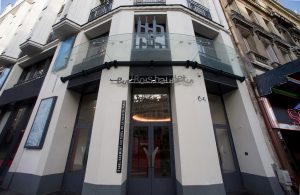 !
!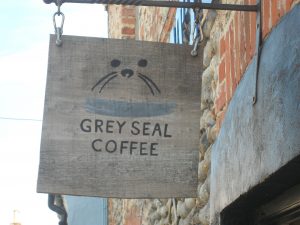 Walking and writing are such complementary activities. The rhythm of walking very much mirrors the rhythms of poetry and I often walk stuck ideas out into the open. I rarely want to write in the style of a flaneur when I’m out in the countryside, it’s very much an urban style after all, a bit like Frank O’Hara’s brilliant lunch poems – you need a busy scene with lots of people and activity and a slightly grungy feel to the whole scenario. When out and about in the great outdoors haiku are the perfect fit – I seem to compose them endlessly the minute I get a whiff of fresh air. This Japanese poetic style is much loved by Westerners. Short, delicate, just three lines and 17 syllables in total (although balance is more important than syllabic perfection), haiku are a great way to record impressions and their focus is usually the natural world and the seasons. The great Japanese haiku master was Matsuo Basho (1644-94), one of my favourites by Basho is:
Walking and writing are such complementary activities. The rhythm of walking very much mirrors the rhythms of poetry and I often walk stuck ideas out into the open. I rarely want to write in the style of a flaneur when I’m out in the countryside, it’s very much an urban style after all, a bit like Frank O’Hara’s brilliant lunch poems – you need a busy scene with lots of people and activity and a slightly grungy feel to the whole scenario. When out and about in the great outdoors haiku are the perfect fit – I seem to compose them endlessly the minute I get a whiff of fresh air. This Japanese poetic style is much loved by Westerners. Short, delicate, just three lines and 17 syllables in total (although balance is more important than syllabic perfection), haiku are a great way to record impressions and their focus is usually the natural world and the seasons. The great Japanese haiku master was Matsuo Basho (1644-94), one of my favourites by Basho is: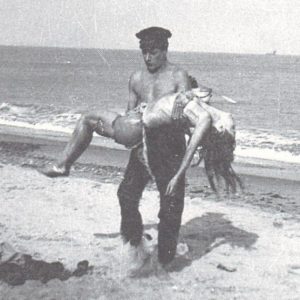 One of the first feature films to be shot in Norfolk was The Rolling Road in 1927 starring Flora le Breton. Legend has it that the October sea at Great Yarmouth proved too much for the skimpily-clad heroine and she had to be saved by Carlyle Blackwell, her co-star, although some say she was saved not by the film’s hero but by Robert “Chickie” Drane, a Yarmouthian who was an acknowledged champion swimmer and lifesaver and allegedly doubled for Carlyle Blackwell in the aquatic scenes.
One of the first feature films to be shot in Norfolk was The Rolling Road in 1927 starring Flora le Breton. Legend has it that the October sea at Great Yarmouth proved too much for the skimpily-clad heroine and she had to be saved by Carlyle Blackwell, her co-star, although some say she was saved not by the film’s hero but by Robert “Chickie” Drane, a Yarmouthian who was an acknowledged champion swimmer and lifesaver and allegedly doubled for Carlyle Blackwell in the aquatic scenes.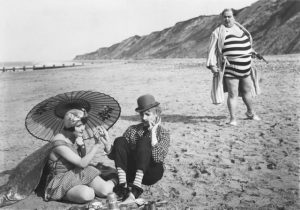 Another notable early film shot partly in Norfolk was Anthony Asquith’s 1928 Shooting Stars. Chili Bouchier won a competition in the Daily Mail to become a film star and here she is as a bathing belle on Cromer beach. One of our classic British films, The Go Between, starring Julie Christie and Alan Bates, was shot in Norfolk using locations at Thornage, Hickling Broad, Holkham, Heydon, Norwich, Melton Constable and Hanworth to evoke the hottest day of the year in 1900. Norfolk is so held in time that I often feel I am walking in the past evoked by these films, until my next stop for an expresso shot at the defiantly 21st century Grey Seal, that is!
Another notable early film shot partly in Norfolk was Anthony Asquith’s 1928 Shooting Stars. Chili Bouchier won a competition in the Daily Mail to become a film star and here she is as a bathing belle on Cromer beach. One of our classic British films, The Go Between, starring Julie Christie and Alan Bates, was shot in Norfolk using locations at Thornage, Hickling Broad, Holkham, Heydon, Norwich, Melton Constable and Hanworth to evoke the hottest day of the year in 1900. Norfolk is so held in time that I often feel I am walking in the past evoked by these films, until my next stop for an expresso shot at the defiantly 21st century Grey Seal, that is!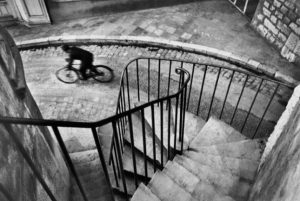 Understandably, I’ve been writing a lot about place recently and I’ve been contemplating whether we remember places in black and white or colour. This has probably been further fuelled by a visit to the fantastic Henri Cartier-Bresson exhibition at the Sainsbury Centre for Visual Arts in Norwich. It’s a really well curated exhibition, spacious and meditative with peculiarly haunting images: boules players discussing strategy in the snow, ancient prams full of wartime finds, a photographer taking a group of gypsies, the heartbreaking faces of mourners after the Rue de Charonne massacre in the 1960s and this wonderful image of a cyclist and stairway. Strangely, when I think of Paris, the colours are very muted, almost wintery, in my mind. Other places appear in my memory in quite clichéd colours, so India is saffron and bright pink and Mexico memories are in earthy, sandy, almost terracotta colours. Try this yourselves, poets, it’s a good exercise – the colour of memory… It reminded me of all those films which play with the idea of black and white and colour – A Matter of Life and Death (where heaven is black and white and earth is in colour), Stalker – a Russian re-telling of the Wizard of Oz combined with the marvellous Strugatsky Brothers sci-fi novel Roadside Picnic – here the Zone is in colour (where your dreams come true) and the contaminated Russian industrial-scape is, of course, black and white.
Understandably, I’ve been writing a lot about place recently and I’ve been contemplating whether we remember places in black and white or colour. This has probably been further fuelled by a visit to the fantastic Henri Cartier-Bresson exhibition at the Sainsbury Centre for Visual Arts in Norwich. It’s a really well curated exhibition, spacious and meditative with peculiarly haunting images: boules players discussing strategy in the snow, ancient prams full of wartime finds, a photographer taking a group of gypsies, the heartbreaking faces of mourners after the Rue de Charonne massacre in the 1960s and this wonderful image of a cyclist and stairway. Strangely, when I think of Paris, the colours are very muted, almost wintery, in my mind. Other places appear in my memory in quite clichéd colours, so India is saffron and bright pink and Mexico memories are in earthy, sandy, almost terracotta colours. Try this yourselves, poets, it’s a good exercise – the colour of memory… It reminded me of all those films which play with the idea of black and white and colour – A Matter of Life and Death (where heaven is black and white and earth is in colour), Stalker – a Russian re-telling of the Wizard of Oz combined with the marvellous Strugatsky Brothers sci-fi novel Roadside Picnic – here the Zone is in colour (where your dreams come true) and the contaminated Russian industrial-scape is, of course, black and white.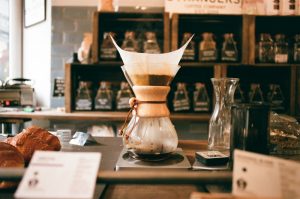 And if you do happen to be passing through Norwich, check out two fabulous cafes with their own roasteries and excellent craft coffee. Little Red Roaster is at 1a St Andrew’s Street, also 81b Grove Road and they have a good sized stall on the market too (52/53). Strangers Coffee Company on Dove Street are the new kids on the block and at present are for takeaways only. If you fancy tea (and cake!) the rather eccentric Biddy’s Tea Room is good for people-watching and writerly inspiration – tucked away on Lower Goat Lane, it’s got a slight air of the Mad Hatter’s Tea Party and has a monthly bake-off and a clothes swapping evening, both of which sound intriguing!
And if you do happen to be passing through Norwich, check out two fabulous cafes with their own roasteries and excellent craft coffee. Little Red Roaster is at 1a St Andrew’s Street, also 81b Grove Road and they have a good sized stall on the market too (52/53). Strangers Coffee Company on Dove Street are the new kids on the block and at present are for takeaways only. If you fancy tea (and cake!) the rather eccentric Biddy’s Tea Room is good for people-watching and writerly inspiration – tucked away on Lower Goat Lane, it’s got a slight air of the Mad Hatter’s Tea Party and has a monthly bake-off and a clothes swapping evening, both of which sound intriguing!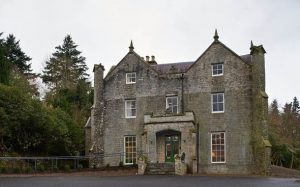 I have just returned from an Arvon residential writing course taught by the most inspiring and generous poet-tutors one could possibly hope to have – Caroline Bird and Kei Miller. Kei is a Jamaican poet and we did a lot of work on ideas around place in his sessions, fitting in beautifully with my current obsession (he was very patient when I started every sentence with “In Paris…”); while Caroline stretched our perception of what poetry can do to an alarming and quite brilliant extent. All this took place in John Osborne’s old house, The Hurst, in the rolling English countryside near Clun. Heaven!
I have just returned from an Arvon residential writing course taught by the most inspiring and generous poet-tutors one could possibly hope to have – Caroline Bird and Kei Miller. Kei is a Jamaican poet and we did a lot of work on ideas around place in his sessions, fitting in beautifully with my current obsession (he was very patient when I started every sentence with “In Paris…”); while Caroline stretched our perception of what poetry can do to an alarming and quite brilliant extent. All this took place in John Osborne’s old house, The Hurst, in the rolling English countryside near Clun. Heaven!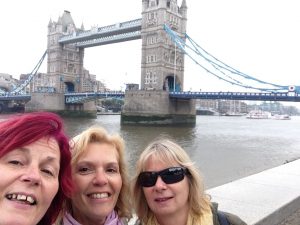 London, now there’s a place I always see in sepia… And most colour-appropriately I stayed there recently at an Airbnb in Bermondsey with two friends, Claire and Monika, who I hadn’t seen for around twenty-five years. We’d all been in Israel together, kept in touch for an intense seven or eight years and then drifted apart. We had a great weekend of catching-up and it felt as if we’d seen each other weeks rather than years ago.
London, now there’s a place I always see in sepia… And most colour-appropriately I stayed there recently at an Airbnb in Bermondsey with two friends, Claire and Monika, who I hadn’t seen for around twenty-five years. We’d all been in Israel together, kept in touch for an intense seven or eight years and then drifted apart. We had a great weekend of catching-up and it felt as if we’d seen each other weeks rather than years ago.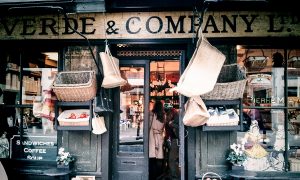
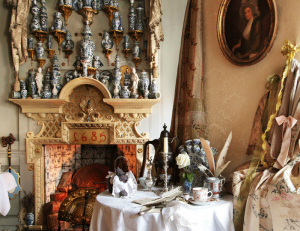 Which brings me neatly to my second London gem a stone’s throw from Verde and Company – Dennis Severs’ House at 18, Folgate Street. It’s not easy to describe this place and, be warned, it’s not open often, just Sundays and Mondays and your visit will be in complete, candlelit silence. Severs was an artist who lived in this house much as its 18th century inhabitants had before him and thirty years ago he decided to share this experience with visitors. The house is like a stage set and a time capsule, a series of paintings you stumble in to, seemingly just as the inhabitants have left – gaming dice flung on the table, a glass broken on the floor, a clock chiming, wistful traces of Huguenot weavers, the smell of oranges in the air… Each room creates a different mood and evokes different inhabitants. The house’s ten rooms harbour ten ‘spells’ that engage the visitor’s imagination in moods that dominated the periods between 1724 – 1914. Your senses are your guide. Severs called this experience “still-life drama” and it works beautifully. I’ve been going annually for years (I could swear the same black cat – yes, it’s definitely live! – skulks around the kitchen and front room, perhaps attracted to the cheeping of the stuffed canary…
Which brings me neatly to my second London gem a stone’s throw from Verde and Company – Dennis Severs’ House at 18, Folgate Street. It’s not easy to describe this place and, be warned, it’s not open often, just Sundays and Mondays and your visit will be in complete, candlelit silence. Severs was an artist who lived in this house much as its 18th century inhabitants had before him and thirty years ago he decided to share this experience with visitors. The house is like a stage set and a time capsule, a series of paintings you stumble in to, seemingly just as the inhabitants have left – gaming dice flung on the table, a glass broken on the floor, a clock chiming, wistful traces of Huguenot weavers, the smell of oranges in the air… Each room creates a different mood and evokes different inhabitants. The house’s ten rooms harbour ten ‘spells’ that engage the visitor’s imagination in moods that dominated the periods between 1724 – 1914. Your senses are your guide. Severs called this experience “still-life drama” and it works beautifully. I’ve been going annually for years (I could swear the same black cat – yes, it’s definitely live! – skulks around the kitchen and front room, perhaps attracted to the cheeping of the stuffed canary…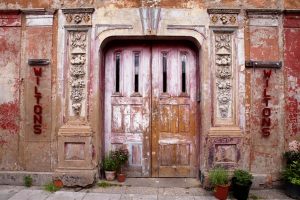 And the third treasure is Wilton’s Music Hall in Graces Alley (about 10 minutes from Tower Hill tube station). The Victorian Music Hall itself is well worth a visit. I saw a fantastic production of The Great Gatsby there a couple of years ago, it’s a wonderful shabby chic space that takes you back to the Good Old Days! Best of all are the series of bar areas at the front of the music hall. Wilton’s started life as a series of five 17th century houses, the largest of which was a pub and which were later combined and subsequently bought and revamped by John Wilton in 1850. The Music Hall he built was popular for around thirty years, with acts like Champagne Charlie (check out the 1944 Ealing comedy Champagne Charlie with Stanley Holloway and Tommy Trinder.) treading the boards. There’s a good history of the site on the Wilton’s website
And the third treasure is Wilton’s Music Hall in Graces Alley (about 10 minutes from Tower Hill tube station). The Victorian Music Hall itself is well worth a visit. I saw a fantastic production of The Great Gatsby there a couple of years ago, it’s a wonderful shabby chic space that takes you back to the Good Old Days! Best of all are the series of bar areas at the front of the music hall. Wilton’s started life as a series of five 17th century houses, the largest of which was a pub and which were later combined and subsequently bought and revamped by John Wilton in 1850. The Music Hall he built was popular for around thirty years, with acts like Champagne Charlie (check out the 1944 Ealing comedy Champagne Charlie with Stanley Holloway and Tommy Trinder.) treading the boards. There’s a good history of the site on the Wilton’s website 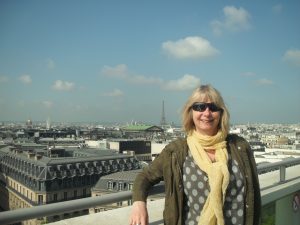 My five week stay in Paris is over and I’ve written thirteen new poems. This is more than my average annual output so I’m feeling very pleased and slightly smug. The combination of one of the most beautiful and inspiring cities in the world, the thematic starting point of considering films set in Paris and my own strong relationship with this city have all done the trick in more ways than I could have hoped. I feel incredibly privileged to have had this opportunity thanks to the grant I received from the Arts Council to develop my writing over the next twelve months. I was so excited by this opportunity that I’d already written the first of the thirteen new poems by the time the train pulled in to the Gare du Nord on Day 1!
My five week stay in Paris is over and I’ve written thirteen new poems. This is more than my average annual output so I’m feeling very pleased and slightly smug. The combination of one of the most beautiful and inspiring cities in the world, the thematic starting point of considering films set in Paris and my own strong relationship with this city have all done the trick in more ways than I could have hoped. I feel incredibly privileged to have had this opportunity thanks to the grant I received from the Arts Council to develop my writing over the next twelve months. I was so excited by this opportunity that I’d already written the first of the thirteen new poems by the time the train pulled in to the Gare du Nord on Day 1! My wonderful rented apartment in Cité de Trevise in the ninth arrondissement was just round the corner from Les Folies Bergeres in Rue Richer. In one direction it was a15-minute walk to République along the Rue Chateau d’Eau which, at certain intersections was like a scene from The Wire, although thankfully far less threatening with cool black guys on the corners doing lots of amicable shouting to each other, the giveaway being the large wads of money they were clutching…. Fifteen minutes the other way and I could be at Opéra Garnier and the Grands Boulevards or Montmartre and Pigalle.
My wonderful rented apartment in Cité de Trevise in the ninth arrondissement was just round the corner from Les Folies Bergeres in Rue Richer. In one direction it was a15-minute walk to République along the Rue Chateau d’Eau which, at certain intersections was like a scene from The Wire, although thankfully far less threatening with cool black guys on the corners doing lots of amicable shouting to each other, the giveaway being the large wads of money they were clutching…. Fifteen minutes the other way and I could be at Opéra Garnier and the Grands Boulevards or Montmartre and Pigalle.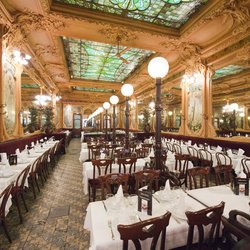 I spent hours wandering the streets checking out film locations, discovering that Julie Delpy’s flat in Before Sunrise was very close to mine in the hard to find Passage des Petites Ecuries. One of Edith Piaf’s favourite restaurants Julien, a belle époque gem where I had a lovely lunch, was just round the corner. Marion Cotillard got to sit in Piaf’s favourite booth when they filmed La Vie en Rose.
I spent hours wandering the streets checking out film locations, discovering that Julie Delpy’s flat in Before Sunrise was very close to mine in the hard to find Passage des Petites Ecuries. One of Edith Piaf’s favourite restaurants Julien, a belle époque gem where I had a lovely lunch, was just round the corner. Marion Cotillard got to sit in Piaf’s favourite booth when they filmed La Vie en Rose.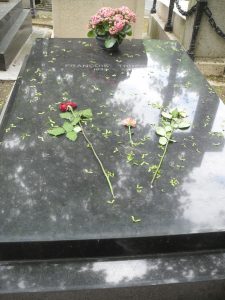 One of my favourites was the Truffaut walk. I began my stay in Paris looking for Truffaut’s grave in Montmartre Cemetery and after several fruitless, but very enjoyable, visits gave up until Juliette pointed me in the right direction and I finished my stay in Paris by finding him. Strange how things come full circle…
One of my favourites was the Truffaut walk. I began my stay in Paris looking for Truffaut’s grave in Montmartre Cemetery and after several fruitless, but very enjoyable, visits gave up until Juliette pointed me in the right direction and I finished my stay in Paris by finding him. Strange how things come full circle…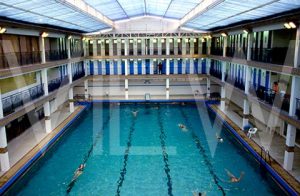 It was interesting to see how intensely blue they had made this environment in the film (otherwise it’s just a normal swimming pool colour). It’s an art deco pool with two-tier changing rooms and rather an eccentric method of accessing them, hence the long conversation with the attendant – we ended up arguing which city was more beautiful, London or Paris. Paris of course!
It was interesting to see how intensely blue they had made this environment in the film (otherwise it’s just a normal swimming pool colour). It’s an art deco pool with two-tier changing rooms and rather an eccentric method of accessing them, hence the long conversation with the attendant – we ended up arguing which city was more beautiful, London or Paris. Paris of course! I first met Grace at Shakespeare & Company at the launch of Emma Beddington’s We’ll Always Have Paris, a witty memoir about failing to live successfully in the city. I would strongly recommend checking out the events listings for Shakespeare & Company. The new cafe next door has the best expresso in town and one of the best views (opposite Notre Dame no less!) and it’s a truly iconic bookshop with a fascinating history. Sadly, the founder, George Whitman, died recently but his daughter Sylvia is carrying on the very good work. I went back towards the end of my stay for a poetry reading by Jack Hirschman and Heather Hartley. Heather Hartley’s excellent Adult Swim is well worth a look and Jack, well, he’s just a legend. A Beat poet, sacked by UCLA for encouraging his students to dodge the draft, he read from The Viet Arcane, a collection that has been many years in the making. His delivery was pure Beat and after each passionately delivered poem his French translator took the stage and read beautifully crafted translations. As we staggered outside we noticed that there were chairs in the little courtyard with relay speakers…. so my other recommendation is, always get there early for S and Co readings!
I first met Grace at Shakespeare & Company at the launch of Emma Beddington’s We’ll Always Have Paris, a witty memoir about failing to live successfully in the city. I would strongly recommend checking out the events listings for Shakespeare & Company. The new cafe next door has the best expresso in town and one of the best views (opposite Notre Dame no less!) and it’s a truly iconic bookshop with a fascinating history. Sadly, the founder, George Whitman, died recently but his daughter Sylvia is carrying on the very good work. I went back towards the end of my stay for a poetry reading by Jack Hirschman and Heather Hartley. Heather Hartley’s excellent Adult Swim is well worth a look and Jack, well, he’s just a legend. A Beat poet, sacked by UCLA for encouraging his students to dodge the draft, he read from The Viet Arcane, a collection that has been many years in the making. His delivery was pure Beat and after each passionately delivered poem his French translator took the stage and read beautifully crafted translations. As we staggered outside we noticed that there were chairs in the little courtyard with relay speakers…. so my other recommendation is, always get there early for S and Co readings!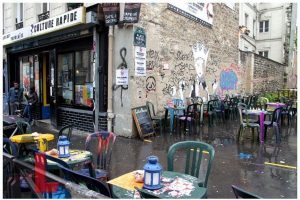 Boosted by Grace I went to the zany Café Culture Rapide in Belleville where they have open mic evenings and tried out two of my new poems on a very supportive audience, although slightly freaked out by the ritual that if it’s your first time there they shriek “Virgin! Virgin!” as you battle your way to the stage.
Boosted by Grace I went to the zany Café Culture Rapide in Belleville where they have open mic evenings and tried out two of my new poems on a very supportive audience, although slightly freaked out by the ritual that if it’s your first time there they shriek “Virgin! Virgin!” as you battle your way to the stage.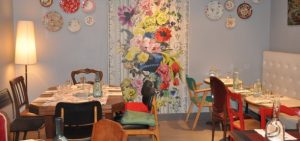 Did I find a substitute for Le Charlotte en L’Isle (see Paris Part II – Rue de Lappe)? I did indeed, the wonderful My Place in Rue St Lazare, bursting with Parisian shabby chic and lovely home-made food.
Did I find a substitute for Le Charlotte en L’Isle (see Paris Part II – Rue de Lappe)? I did indeed, the wonderful My Place in Rue St Lazare, bursting with Parisian shabby chic and lovely home-made food.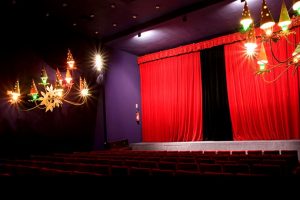 On the 11 May I met Jack Toye (Picturehouse Cambridge Marketing Manager) and Sarah McIntosh (Cambridge Film Festival Short Film Programmer) for a strong early morning coffee at Gare du Lyon and then waved them off, slightly green-tinged with envy, as they sped southwards for ten days at the Cannes Film Festival. I compensated by going to iconic cinema Studio 28 in Montmartre to see the Cannes opening ceremony followed by a preview of the opening night film Woody Allen’s Café Society. What’s so special about Studio 28? Ah, so many things, for a start it has wacky chandeliers designed by Jean Cocteau and it’s the cinema Amélie goes to watch the audience rather than the film. It was one of the first arthouse cinemas in Paris, opening in 1928 with Abel Gance’s Napoléon and the scene of a riot in 1930 at the première of Buῆuel’s L’Age d’Or.
On the 11 May I met Jack Toye (Picturehouse Cambridge Marketing Manager) and Sarah McIntosh (Cambridge Film Festival Short Film Programmer) for a strong early morning coffee at Gare du Lyon and then waved them off, slightly green-tinged with envy, as they sped southwards for ten days at the Cannes Film Festival. I compensated by going to iconic cinema Studio 28 in Montmartre to see the Cannes opening ceremony followed by a preview of the opening night film Woody Allen’s Café Society. What’s so special about Studio 28? Ah, so many things, for a start it has wacky chandeliers designed by Jean Cocteau and it’s the cinema Amélie goes to watch the audience rather than the film. It was one of the first arthouse cinemas in Paris, opening in 1928 with Abel Gance’s Napoléon and the scene of a riot in 1930 at the première of Buῆuel’s L’Age d’Or.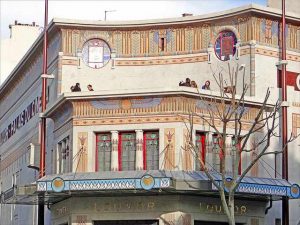 A short walk from my apartment was the Luxour which soon became my local cinema. It’s the most gorgeously restored 1921 picture palace opposite the elevated metro at Barbès Rochechouart so it could have been my local cinema when I lived there in the 1980s but at that time it was the largest gay nightclub in Paris. One of the many films I saw here was The Extravagant Mr Deeds, with my oldest friend and fellow cinephile Sally, during the cinema’s Capra season.
A short walk from my apartment was the Luxour which soon became my local cinema. It’s the most gorgeously restored 1921 picture palace opposite the elevated metro at Barbès Rochechouart so it could have been my local cinema when I lived there in the 1980s but at that time it was the largest gay nightclub in Paris. One of the many films I saw here was The Extravagant Mr Deeds, with my oldest friend and fellow cinephile Sally, during the cinema’s Capra season.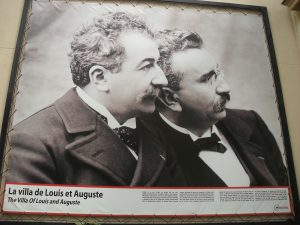 I did a one-day research trip which was really enjoyable – a quick zip down to Lyons to check out the Institut Lumière, one of the places that can truly claim to be the birthplace of cinema as we know it today. I stood on the spot where the cinematograph had been placed to film the Lumière factory workers leaving their shift, one of the earliest films and one which was included in the nine films shown to the first paying audience at the Salon Indien in the Grand Café (now the basement conference room in the Hotel Scribe on Boulevard des Capucines).
I did a one-day research trip which was really enjoyable – a quick zip down to Lyons to check out the Institut Lumière, one of the places that can truly claim to be the birthplace of cinema as we know it today. I stood on the spot where the cinematograph had been placed to film the Lumière factory workers leaving their shift, one of the earliest films and one which was included in the nine films shown to the first paying audience at the Salon Indien in the Grand Café (now the basement conference room in the Hotel Scribe on Boulevard des Capucines).
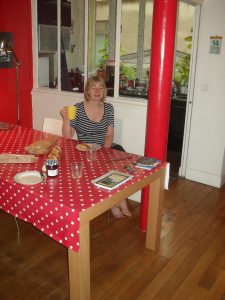
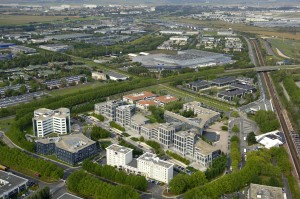 By 1986 I’d completed my second year at the University of East Anglia studying French language, linguistics and literature with a teacher training module or two thrown in. A year abroad in Paris held no fears for me until I discovered that I’d been assigned a really rough secondary school in the banlieue in Villepinte. It wasn’t quite La Haine and there were some great kids in the school, but I was locked in a cupboard, pushed down the stairs and had my naughtiest boys driving mopeds straight at me as I tried to walk to the RER station. I later discovered that the most unpopular teacher who, coincidentally, had the most difficult class, had divided up her class in order to give me the most problematic elements of the whole school. I remember the Directeur (head teacher) telling one of these boys off and the older brother coming in after school and beating him so badly he ended up in hospital. I survived fairly unscathed and it helped me realise I probably wasn’t cut out for teaching children…
By 1986 I’d completed my second year at the University of East Anglia studying French language, linguistics and literature with a teacher training module or two thrown in. A year abroad in Paris held no fears for me until I discovered that I’d been assigned a really rough secondary school in the banlieue in Villepinte. It wasn’t quite La Haine and there were some great kids in the school, but I was locked in a cupboard, pushed down the stairs and had my naughtiest boys driving mopeds straight at me as I tried to walk to the RER station. I later discovered that the most unpopular teacher who, coincidentally, had the most difficult class, had divided up her class in order to give me the most problematic elements of the whole school. I remember the Directeur (head teacher) telling one of these boys off and the older brother coming in after school and beating him so badly he ended up in hospital. I survived fairly unscathed and it helped me realise I probably wasn’t cut out for teaching children…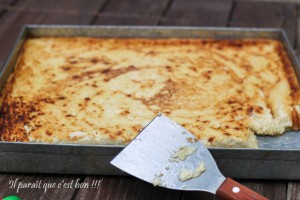 I gave a few private lessons as well – I had a man with no voicebox who wanted to perfect his English pronunciation and also the wonderful Nicole, a pied noir (French but born in the colonies). We met in the queue for free tickets for the Folies Bergères. She lived in a dreadful HLM (habitation à loyer modéré – sort of equivalent to our inner cities) in the suburbs with her four sons – Nicolas, three, Pascal, 13, Patrice, 15 and Jean-Paul 17. When I went round after work I was never quite sure which son I’d be teaching. It was good practice, a bit of pocket money and she always cooked me weird and wonderful food – wheat rissoles and calentica (an Algerian dish made with chick-pea flour) were my favourites!
I gave a few private lessons as well – I had a man with no voicebox who wanted to perfect his English pronunciation and also the wonderful Nicole, a pied noir (French but born in the colonies). We met in the queue for free tickets for the Folies Bergères. She lived in a dreadful HLM (habitation à loyer modéré – sort of equivalent to our inner cities) in the suburbs with her four sons – Nicolas, three, Pascal, 13, Patrice, 15 and Jean-Paul 17. When I went round after work I was never quite sure which son I’d be teaching. It was good practice, a bit of pocket money and she always cooked me weird and wonderful food – wheat rissoles and calentica (an Algerian dish made with chick-pea flour) were my favourites!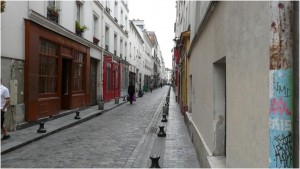 I rented a flat in Rue de Lappe, just off Place Bastille. I had a few pots and pans, a mattress borrowed from a friend of a friend, an old school chair which I’d brought back on the metro from Villepinte, a folding table and a couple of boxes with scarves draped over as side tables. I’ve just been watching Chacun Cherche son Chat (1996 dir. Cedric Klapisch) – made a decade after I lived there but still recognisable as this very run-down working-class district. It was just beginning to gentrify when I arrived, artists’ studios and art galleries so I was constantly going to vernissages (first nights) for free wine and canapés (which is what the lads do in La Haine (1995 dir. Matthieu Kassovitz), although I was much more English and polite!).
I rented a flat in Rue de Lappe, just off Place Bastille. I had a few pots and pans, a mattress borrowed from a friend of a friend, an old school chair which I’d brought back on the metro from Villepinte, a folding table and a couple of boxes with scarves draped over as side tables. I’ve just been watching Chacun Cherche son Chat (1996 dir. Cedric Klapisch) – made a decade after I lived there but still recognisable as this very run-down working-class district. It was just beginning to gentrify when I arrived, artists’ studios and art galleries so I was constantly going to vernissages (first nights) for free wine and canapés (which is what the lads do in La Haine (1995 dir. Matthieu Kassovitz), although I was much more English and polite!). I’m starting to write about this time as part of the Arts Council project. I’ve become very interested in creative geography, Lev Kuleshov’s (Russian film theorist in the early 20th century) idea of putting together different geographical locations, filmed at different times, as if they are all one seamless, unified geographic whole. A really good example of this is the new film version of Macbeth with Michael Fassbender – his castle is Bamburgh Castle on the outside, all rugged and Northern, and Ely Cathedral on the inside, gothic, candlelit lines which don’t fit at all with the outside but the illusion is persistent…
I’m starting to write about this time as part of the Arts Council project. I’ve become very interested in creative geography, Lev Kuleshov’s (Russian film theorist in the early 20th century) idea of putting together different geographical locations, filmed at different times, as if they are all one seamless, unified geographic whole. A really good example of this is the new film version of Macbeth with Michael Fassbender – his castle is Bamburgh Castle on the outside, all rugged and Northern, and Ely Cathedral on the inside, gothic, candlelit lines which don’t fit at all with the outside but the illusion is persistent…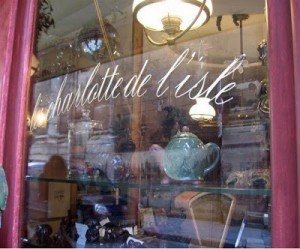 Psycho geography is both similar and different to creative geography, your own personal mood map of your local area… The place I feel most nostalgic about from this period in Paris is La Charlotte de l’Isle – a tiny café and chocolatier on the Isle St Louis where I spent much of my free time writing endless letters (Chris and I had just got together) and notes. Sadly, the café was taken over by new owners in 2010 after 38 years of pure magic and it’s now completely different and utterly unmagical… Sylvie Langlet, eccentric chocolatière and poetess ran the shop and the teashop which were full of treasures, carnival masks, witches on broomsticks, gnomes and marionettes. As well as proper hot chocolate, served in the front room and tiny parlour, she would also serve turkish coffee from an authentic shiny copper turkish coffee pot into tiny, delectable handleless cups. Going to the loo meant you got to see the magical kitchen where Madame would use her antique moulds to make sculptural chocolate concoctions as well as fabulous chocolate dipped florentines.
Psycho geography is both similar and different to creative geography, your own personal mood map of your local area… The place I feel most nostalgic about from this period in Paris is La Charlotte de l’Isle – a tiny café and chocolatier on the Isle St Louis where I spent much of my free time writing endless letters (Chris and I had just got together) and notes. Sadly, the café was taken over by new owners in 2010 after 38 years of pure magic and it’s now completely different and utterly unmagical… Sylvie Langlet, eccentric chocolatière and poetess ran the shop and the teashop which were full of treasures, carnival masks, witches on broomsticks, gnomes and marionettes. As well as proper hot chocolate, served in the front room and tiny parlour, she would also serve turkish coffee from an authentic shiny copper turkish coffee pot into tiny, delectable handleless cups. Going to the loo meant you got to see the magical kitchen where Madame would use her antique moulds to make sculptural chocolate concoctions as well as fabulous chocolate dipped florentines.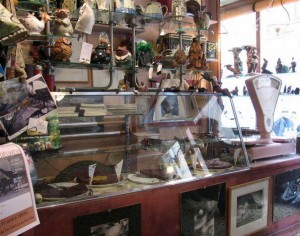
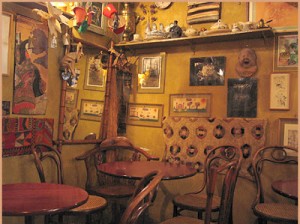
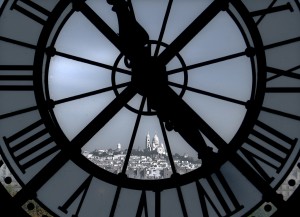
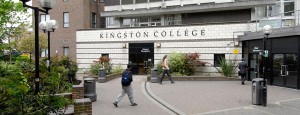
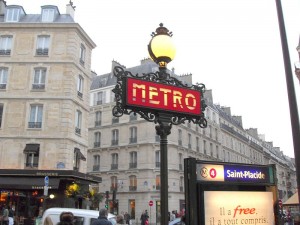 (which I later realised briefly appears in Truffaut’s poignant Antoine et Colette…) we perused the papers for work but instead found an advertisement calling all lonely out-of-towners to a meeting in a café on the outskirts of Paris. There, we discovered an amazing selection of people with varying motivations for coming along. Some had moved from the countryside to work in Paris, others had lived in Paris all their lives but were pieds noirs (ie French but had lived in the French colonies so were culturally very different) or second generation Paris-dwellers from immigrant families who didn’t quite fit in, and, strangest of all were a couple of chic Parisiens, very BCBG*, who seemed to look on the whole adventure as a kind of “feeding time at the zoo” experience. Nevertheless, we all bonded with varying degrees of success and spent the next few months meeting up and having makeshift dinner parties at each others’ flats and generally living in each others’ pockets, literally in the case of D and myself as we were thrown out of our hotel for reporting a theft (long, long story…) and slept on various floors until the wonderful Jean-Paul from Brittany rented a flat at Barbès Rochechouart with room for Diana and me to sling our sleeping bags in a more permanent manner.
(which I later realised briefly appears in Truffaut’s poignant Antoine et Colette…) we perused the papers for work but instead found an advertisement calling all lonely out-of-towners to a meeting in a café on the outskirts of Paris. There, we discovered an amazing selection of people with varying motivations for coming along. Some had moved from the countryside to work in Paris, others had lived in Paris all their lives but were pieds noirs (ie French but had lived in the French colonies so were culturally very different) or second generation Paris-dwellers from immigrant families who didn’t quite fit in, and, strangest of all were a couple of chic Parisiens, very BCBG*, who seemed to look on the whole adventure as a kind of “feeding time at the zoo” experience. Nevertheless, we all bonded with varying degrees of success and spent the next few months meeting up and having makeshift dinner parties at each others’ flats and generally living in each others’ pockets, literally in the case of D and myself as we were thrown out of our hotel for reporting a theft (long, long story…) and slept on various floors until the wonderful Jean-Paul from Brittany rented a flat at Barbès Rochechouart with room for Diana and me to sling our sleeping bags in a more permanent manner.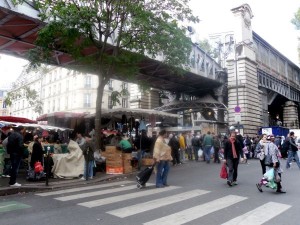
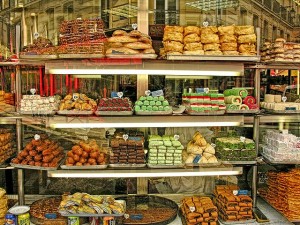
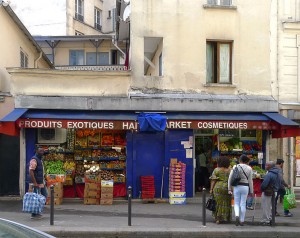 The restaurants were mostly cheap couscouseries with windows full of brightly coloured Moroccan sweets. Women in beautiful African fabrics swanned up and down the roads and I can’t count the number of times the police stopped me because it was too dangerous for a white female to be walking around the area at night – I hated hearing the inevitable barrage of insults when I said I was on my way home…
The restaurants were mostly cheap couscouseries with windows full of brightly coloured Moroccan sweets. Women in beautiful African fabrics swanned up and down the roads and I can’t count the number of times the police stopped me because it was too dangerous for a white female to be walking around the area at night – I hated hearing the inevitable barrage of insults when I said I was on my way home…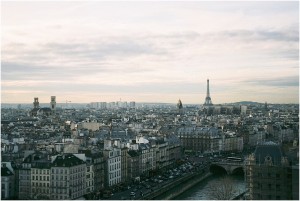 However poor we were, there always seemed to be money for the cinema. Brought up in Kingston-upon-Thames, a stone’s throw from London, and then studying languages, I’d always been a prolific cinema-goer, particularly of foreign films. Jean-Paul was a bit of an international cinema buff and I remember catching up on Kurosawa’s Dersu Uzula and Costa Gavras’ Z and the The Blues Brothers as well as Loulou and Mon Oncle d’Amérique, the latter perhaps flagging up the forthcoming golden age of Depardieu… And, of course, the more I saw of Paris the more I came to appreciate what a truly cinematic city it was, a film-maker and photographer’s dream.
However poor we were, there always seemed to be money for the cinema. Brought up in Kingston-upon-Thames, a stone’s throw from London, and then studying languages, I’d always been a prolific cinema-goer, particularly of foreign films. Jean-Paul was a bit of an international cinema buff and I remember catching up on Kurosawa’s Dersu Uzula and Costa Gavras’ Z and the The Blues Brothers as well as Loulou and Mon Oncle d’Amérique, the latter perhaps flagging up the forthcoming golden age of Depardieu… And, of course, the more I saw of Paris the more I came to appreciate what a truly cinematic city it was, a film-maker and photographer’s dream.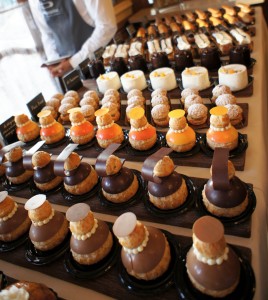
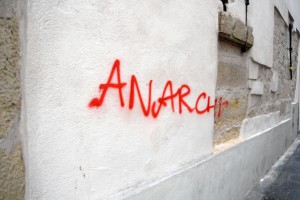 Jean-Paul joined the OCL (Organisation Communiste Libertaire) which sounded very exciting – a French anarchist organisation for goodness sake! I went along a few times but, for anarchists, they certainly loved their endless meetings about “action”…
Jean-Paul joined the OCL (Organisation Communiste Libertaire) which sounded very exciting – a French anarchist organisation for goodness sake! I went along a few times but, for anarchists, they certainly loved their endless meetings about “action”…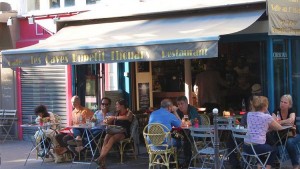 By the time my nineteenth birthday came in the November of that year I had a weltanschauung which was totally different to most of my contemporaries and this hunger for knowledge has never really left me. My second long stay in Paris was equally character forming and who knows what this third trip will bring!
By the time my nineteenth birthday came in the November of that year I had a weltanschauung which was totally different to most of my contemporaries and this hunger for knowledge has never really left me. My second long stay in Paris was equally character forming and who knows what this third trip will bring!
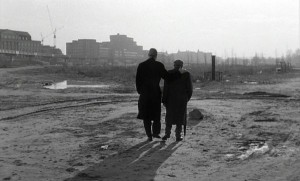
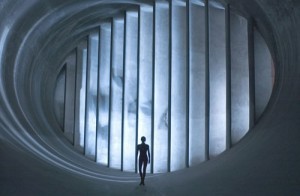
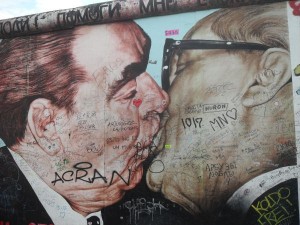
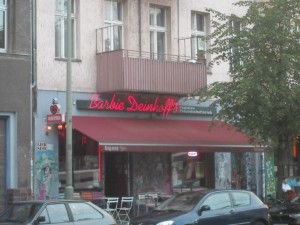
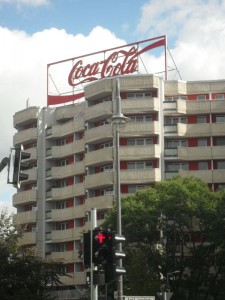 I love this film, it’s so moving. Alex’s mother has a heart attack and goes into a coma just as the Wall comes down. She regains consciousness in a new Germany but mustn’t receive any shocks or she will die. Her son recreates East Berlin all around her, to save her life, for she has been a staunch but humane supporter of the regime. In tribute we go for a daytrip to Lübbenau so I can buy some Spreewald gherkins; Alex searches the newly Westernised supermarkets for these as his mother is craving them, but ends up filling an old Spreewald jar with Western gherkins.
I love this film, it’s so moving. Alex’s mother has a heart attack and goes into a coma just as the Wall comes down. She regains consciousness in a new Germany but mustn’t receive any shocks or she will die. Her son recreates East Berlin all around her, to save her life, for she has been a staunch but humane supporter of the regime. In tribute we go for a daytrip to Lübbenau so I can buy some Spreewald gherkins; Alex searches the newly Westernised supermarkets for these as his mother is craving them, but ends up filling an old Spreewald jar with Western gherkins.